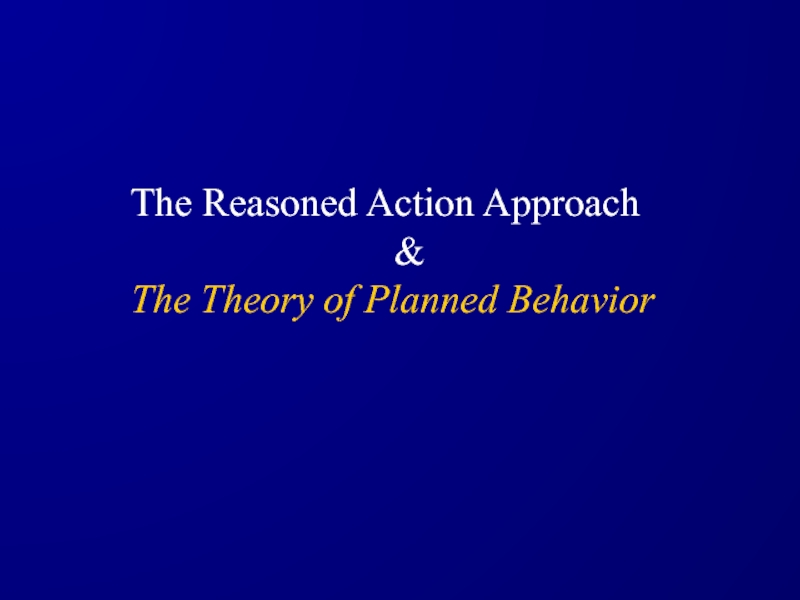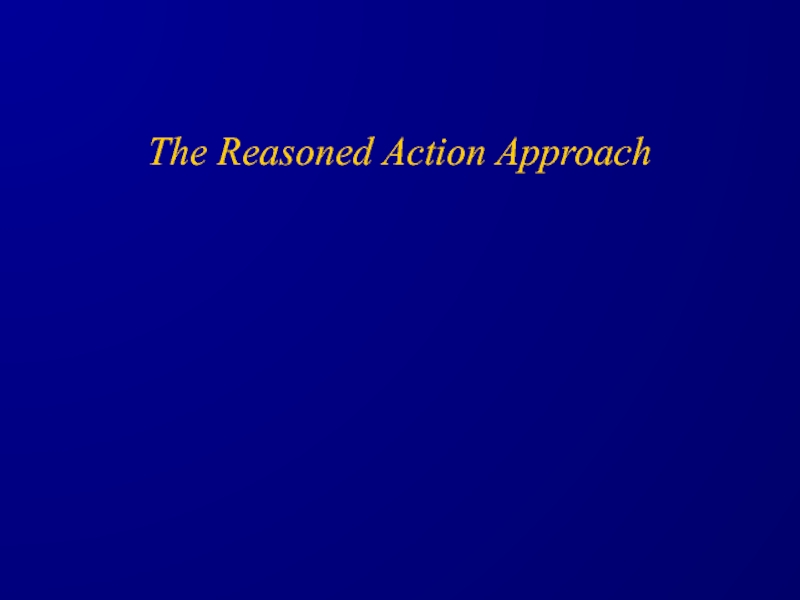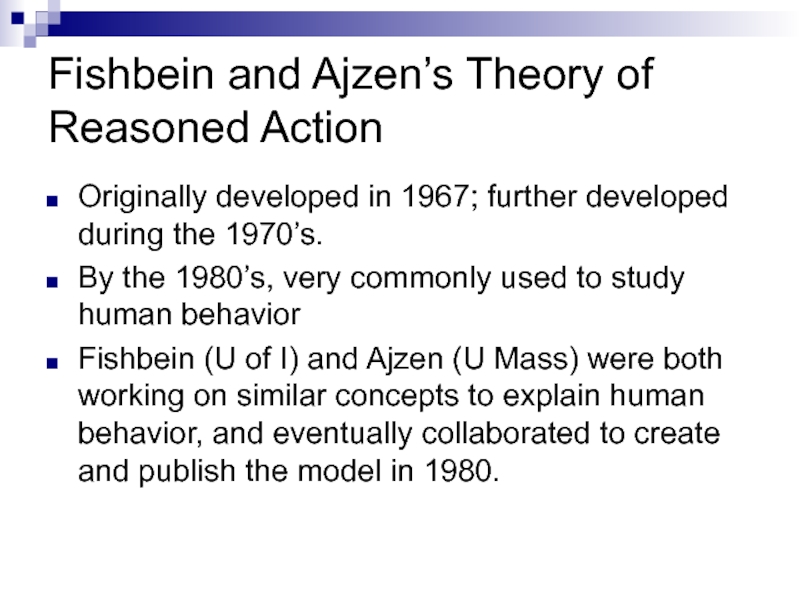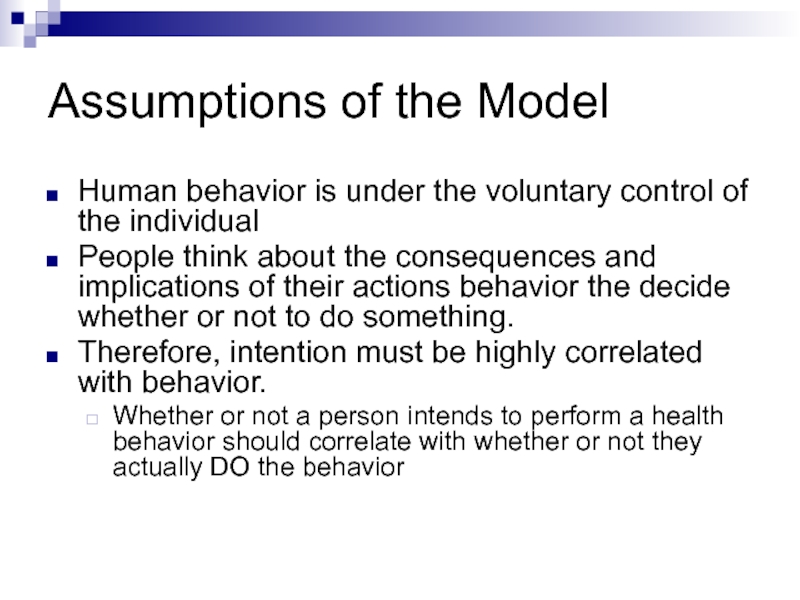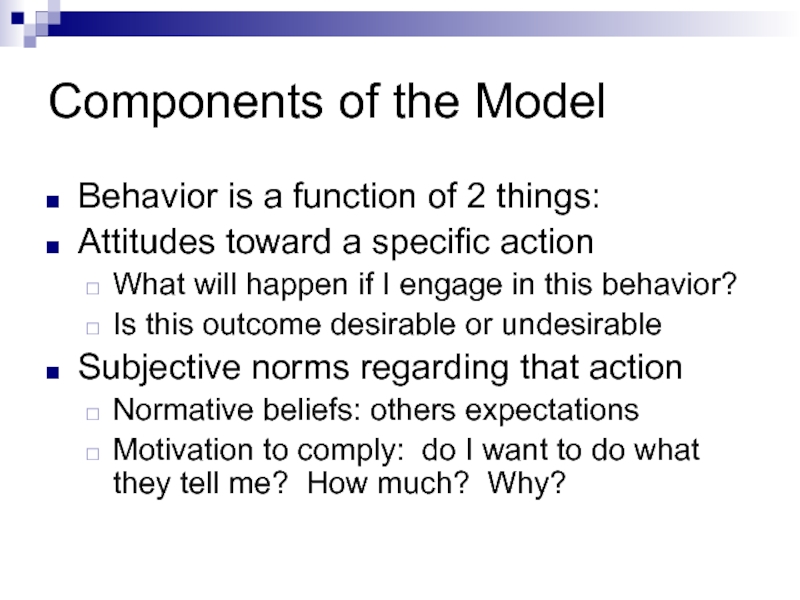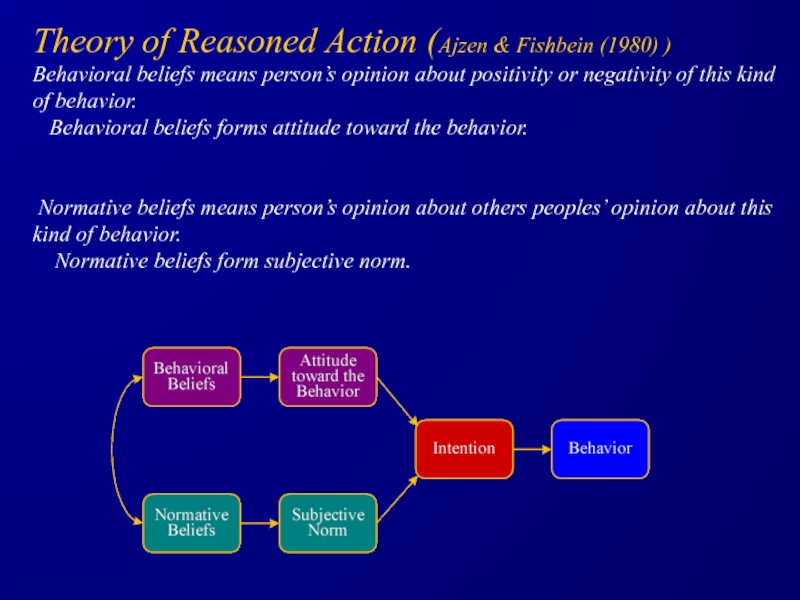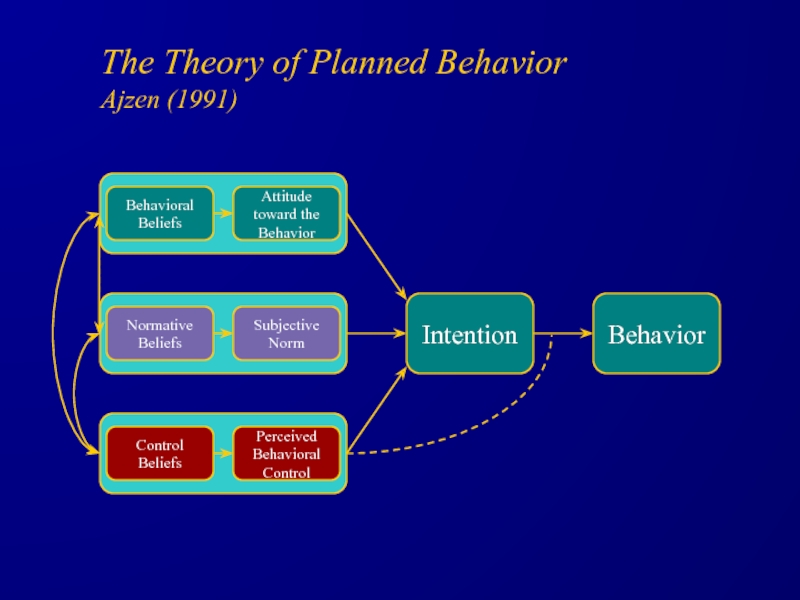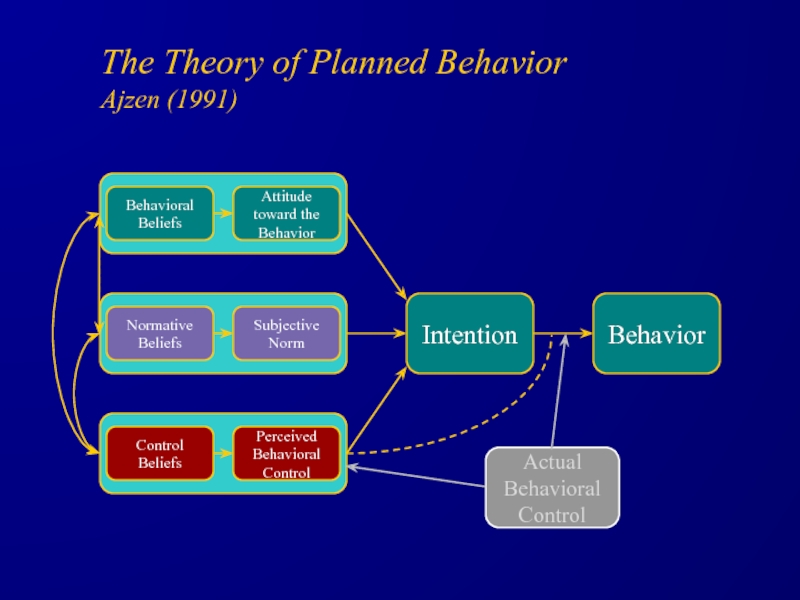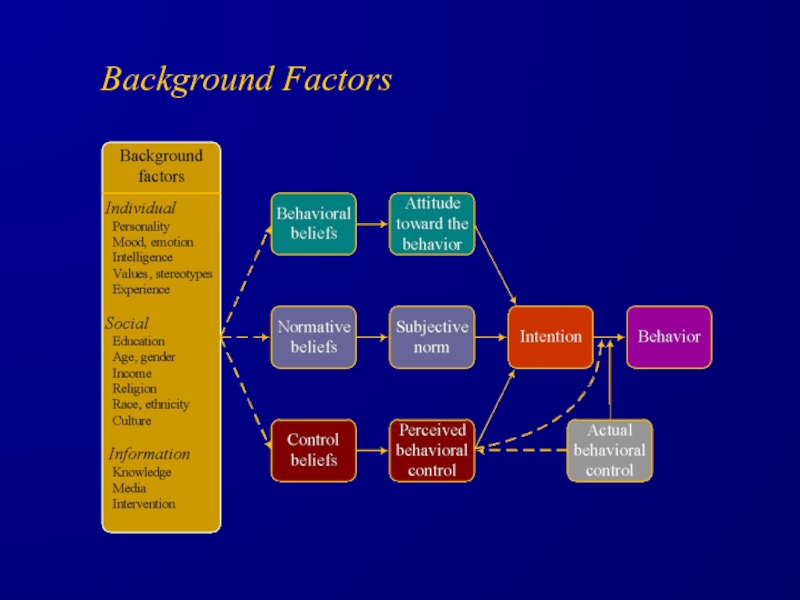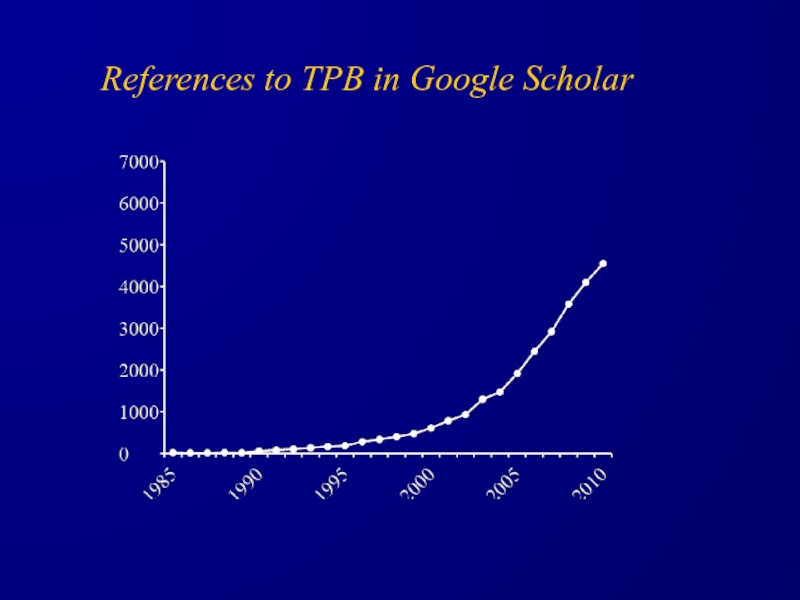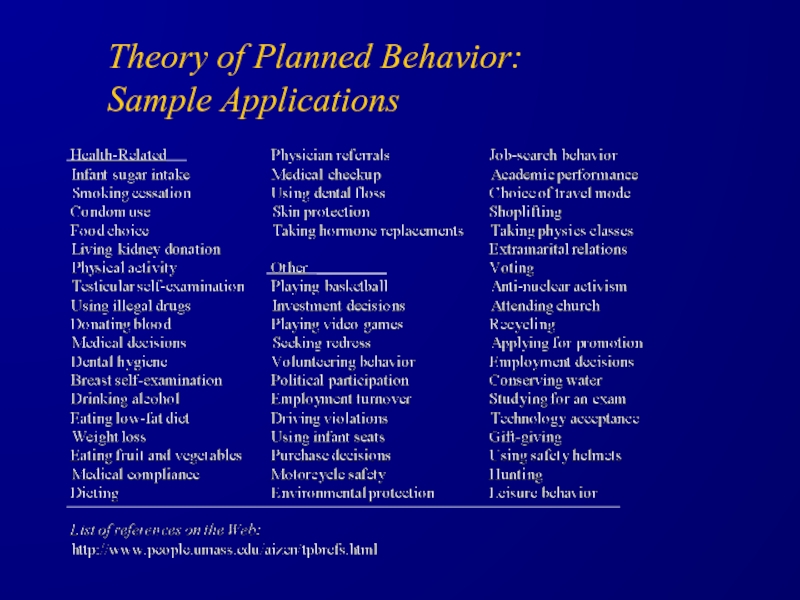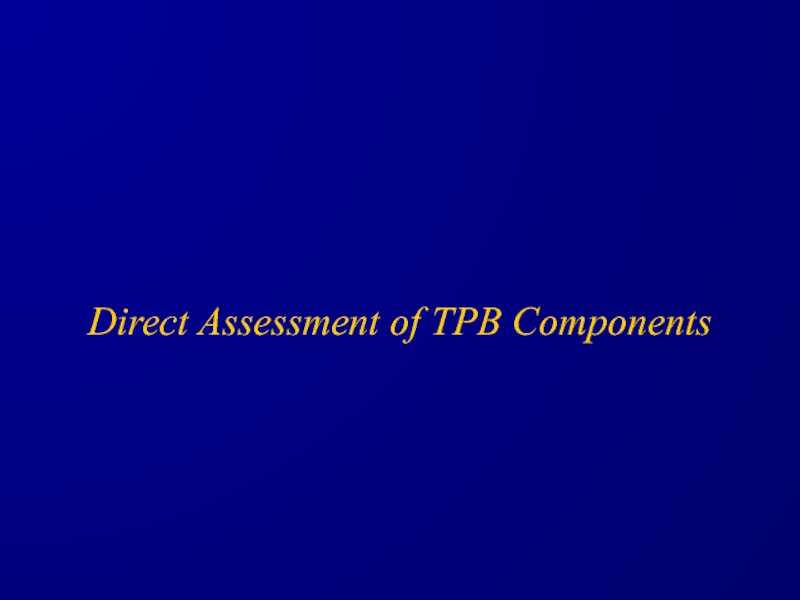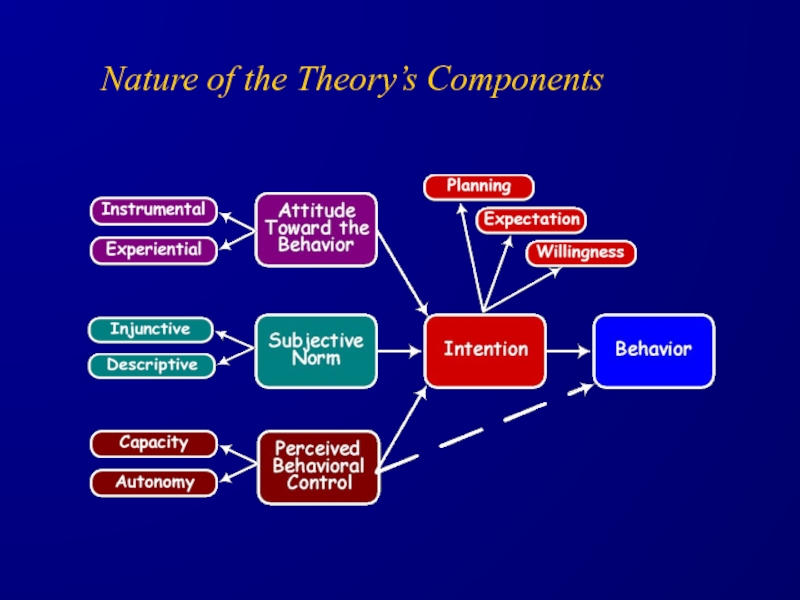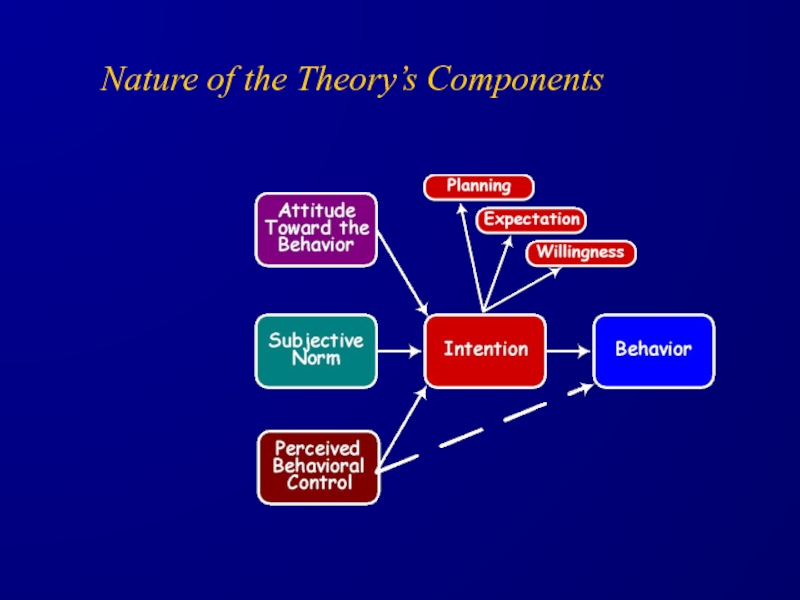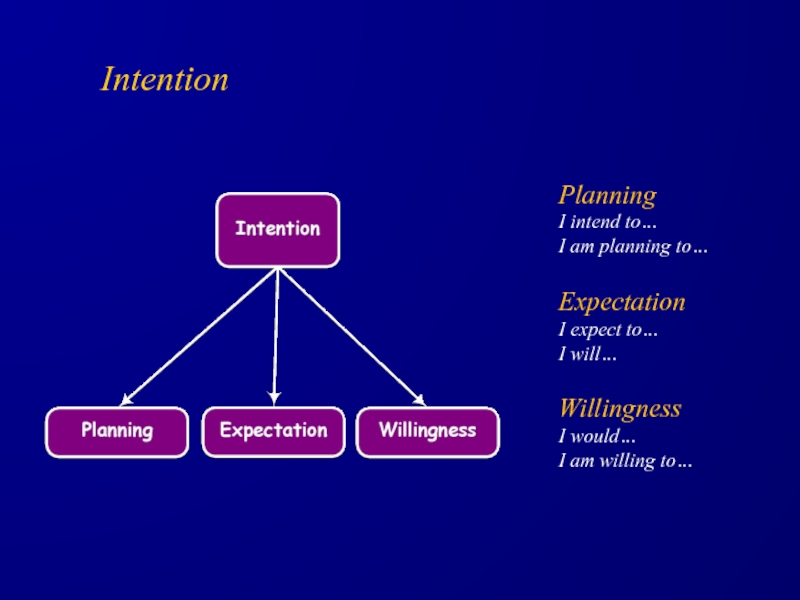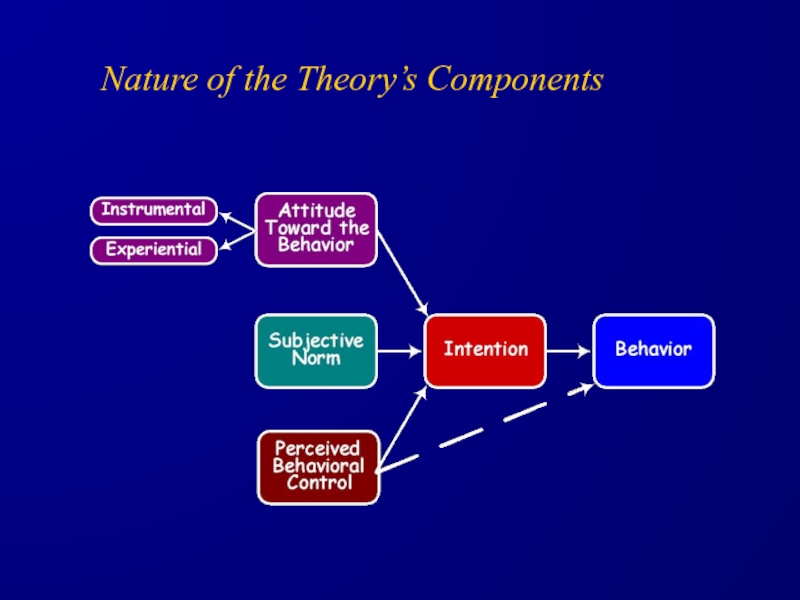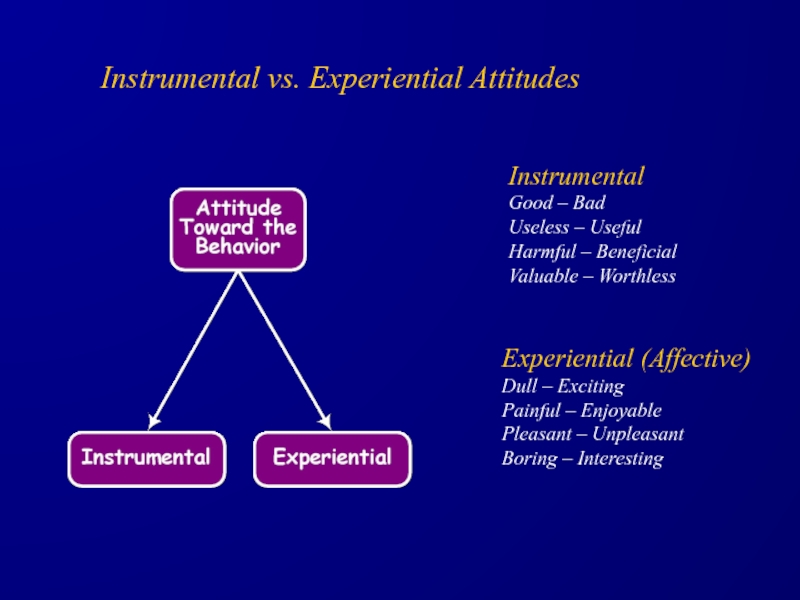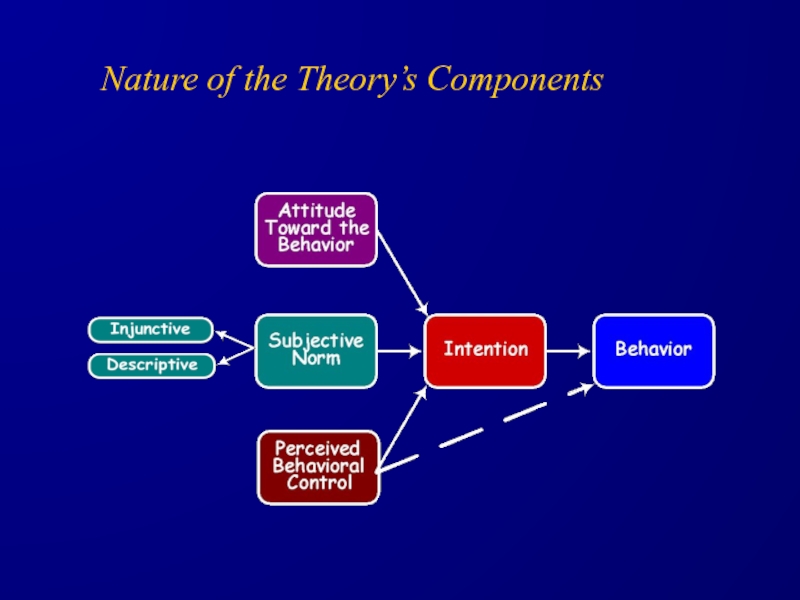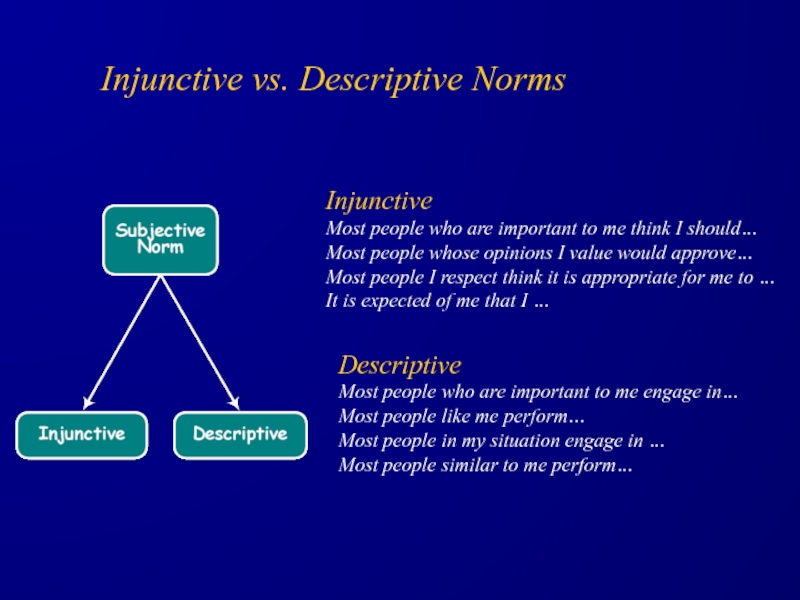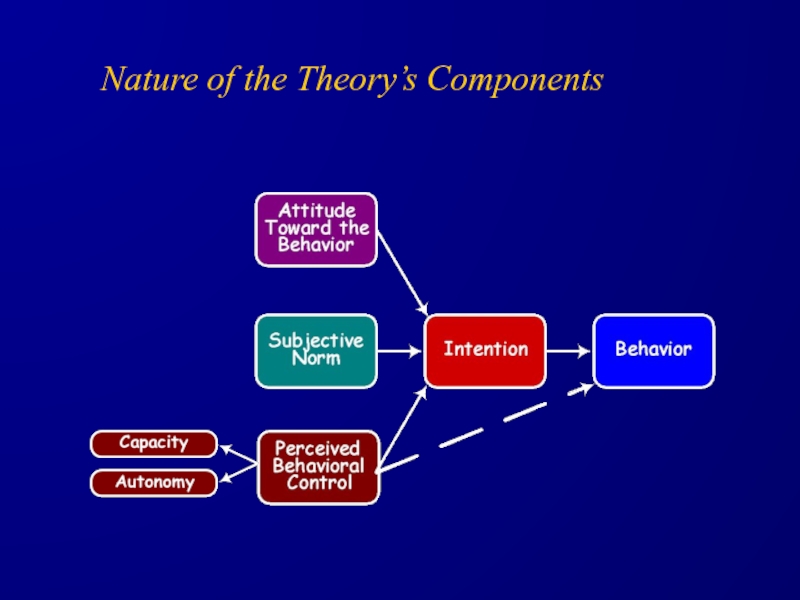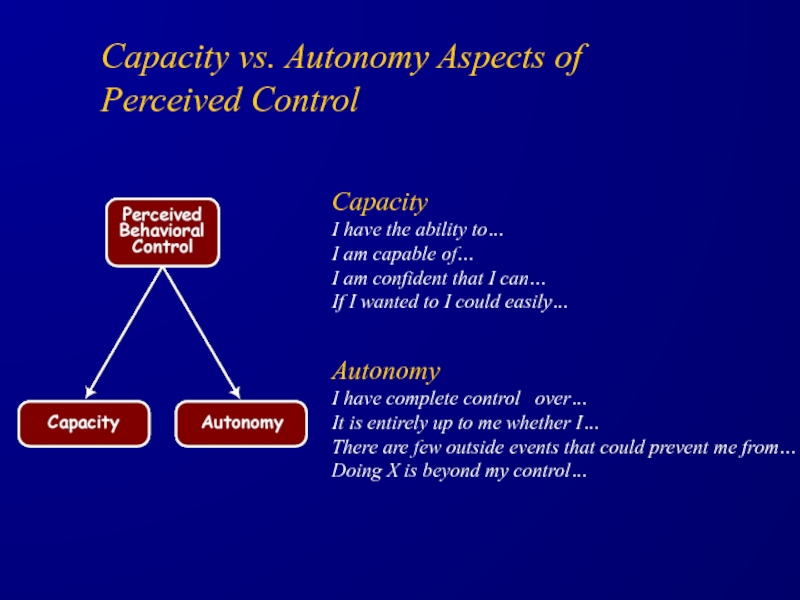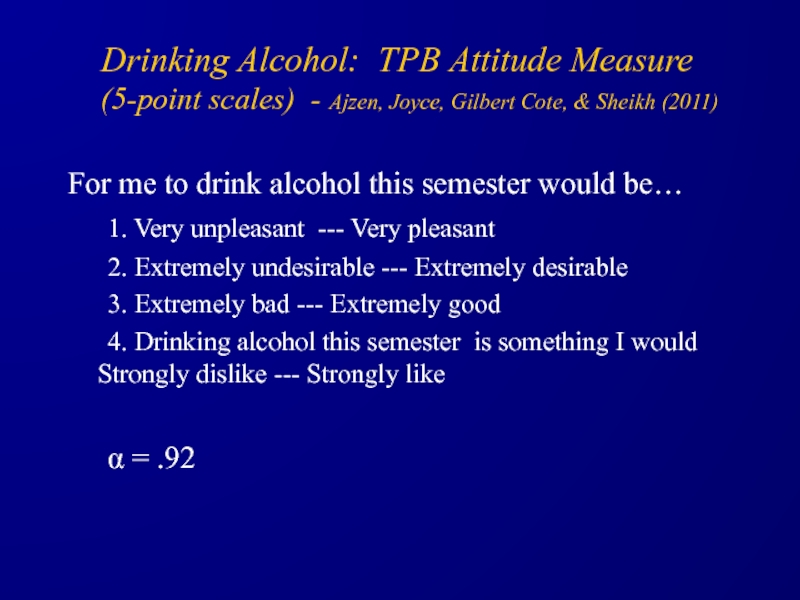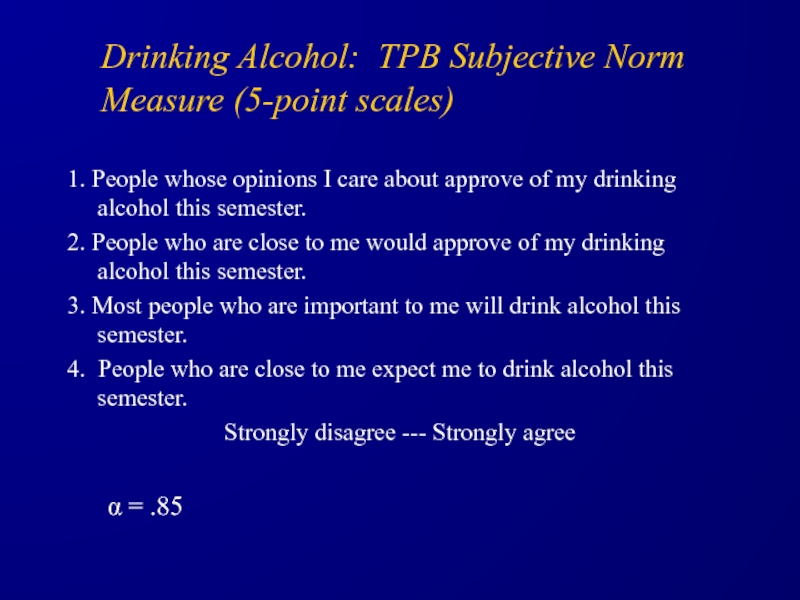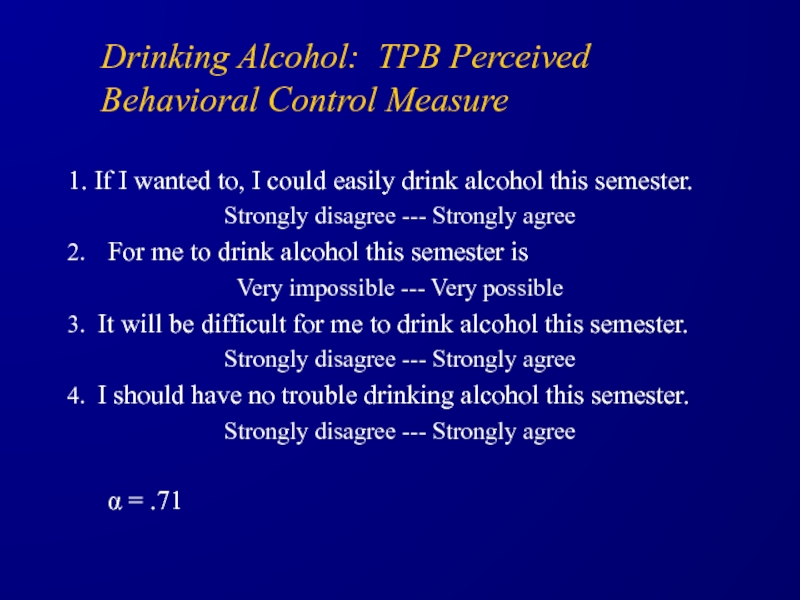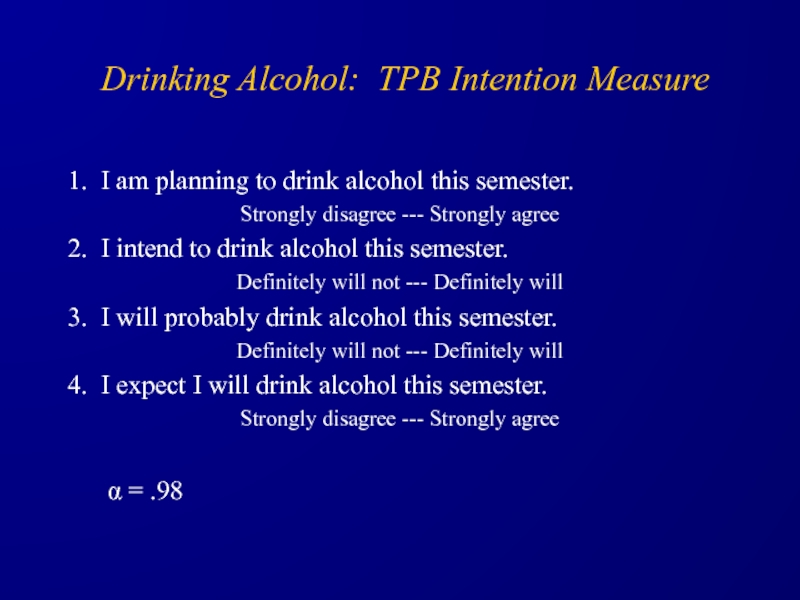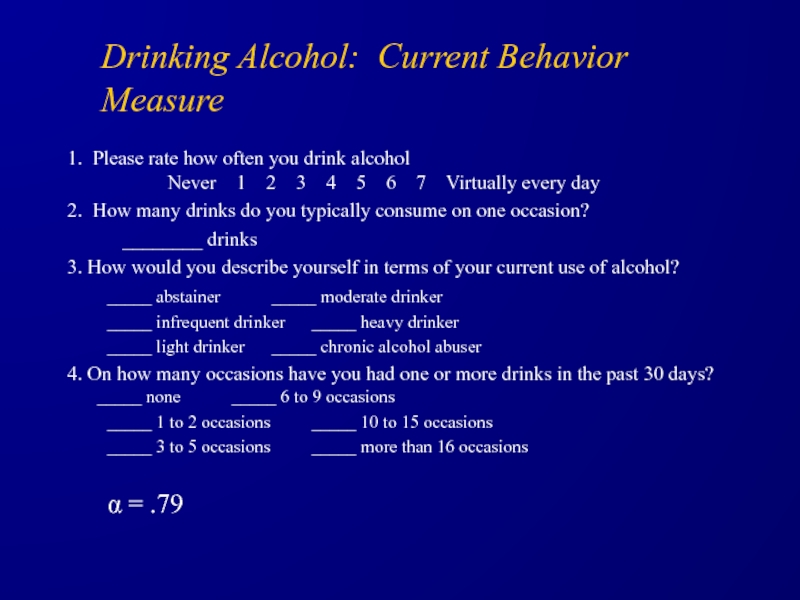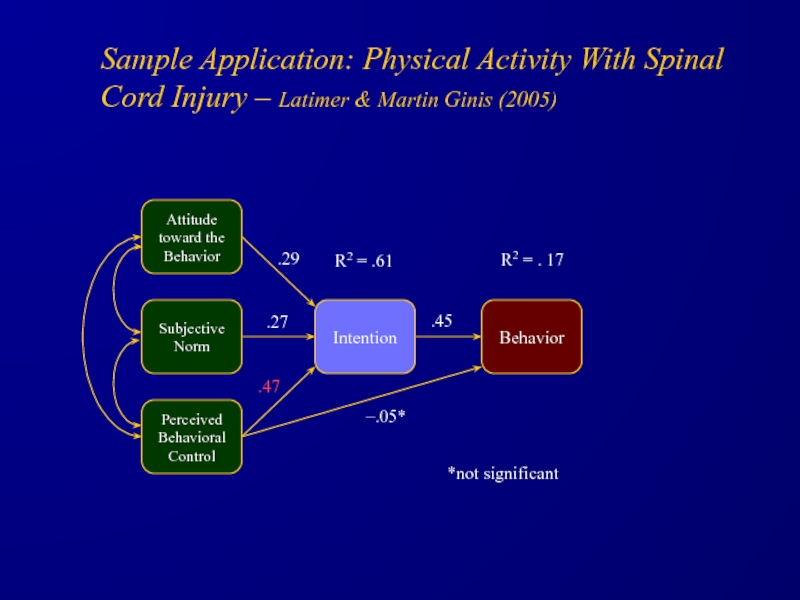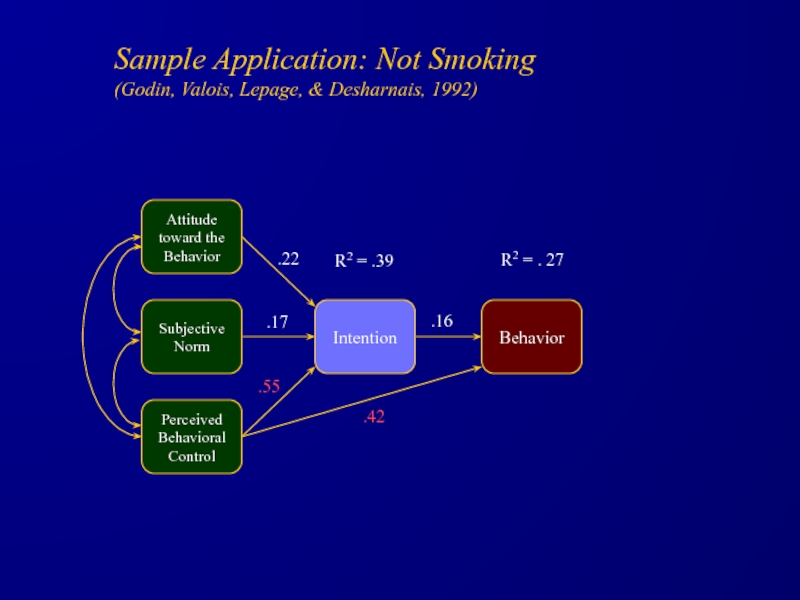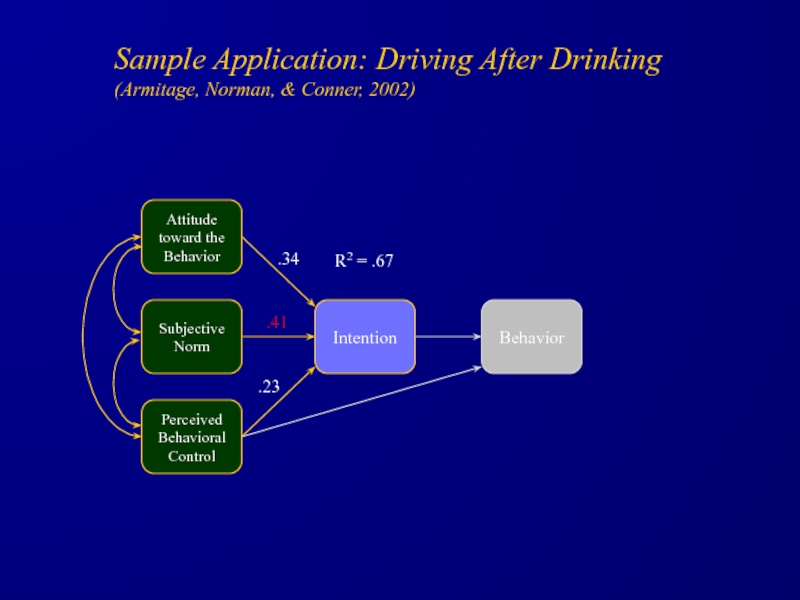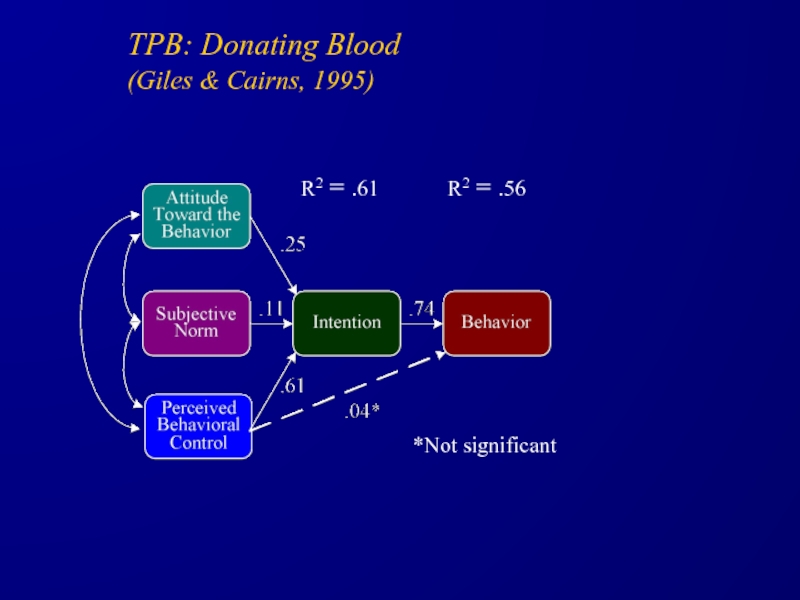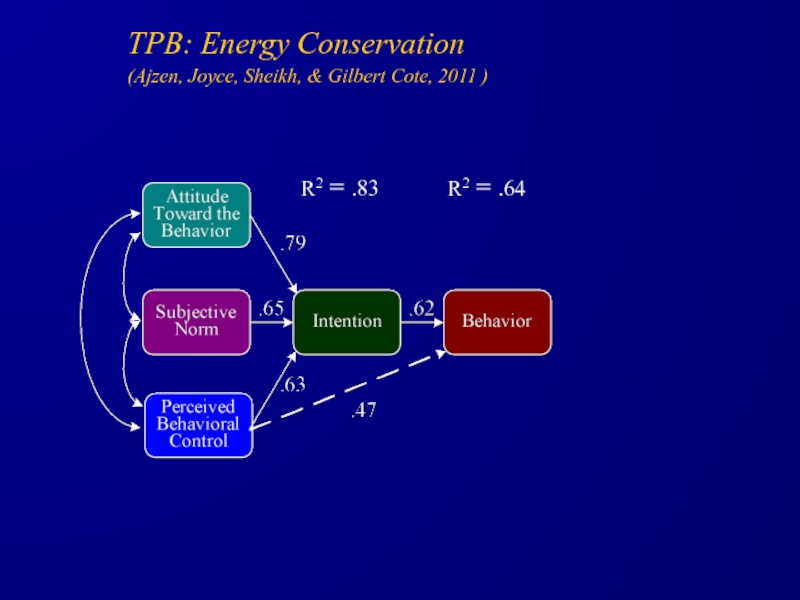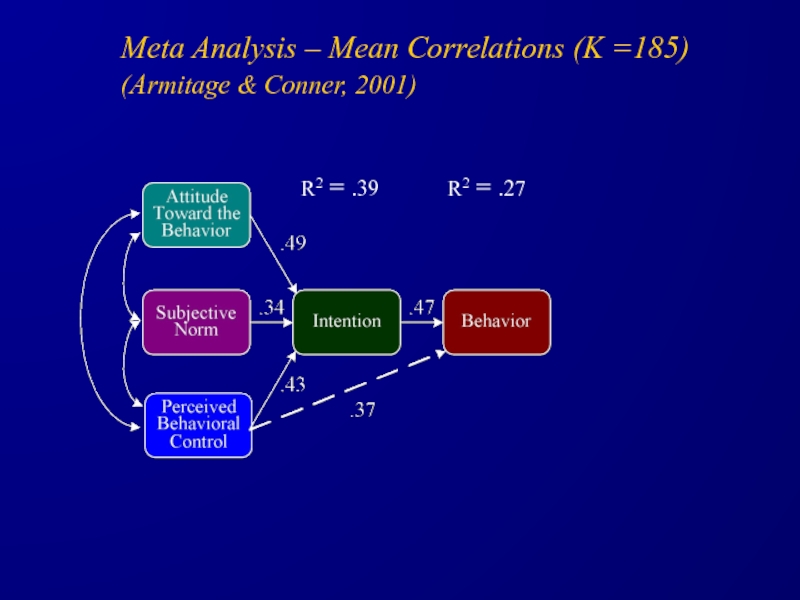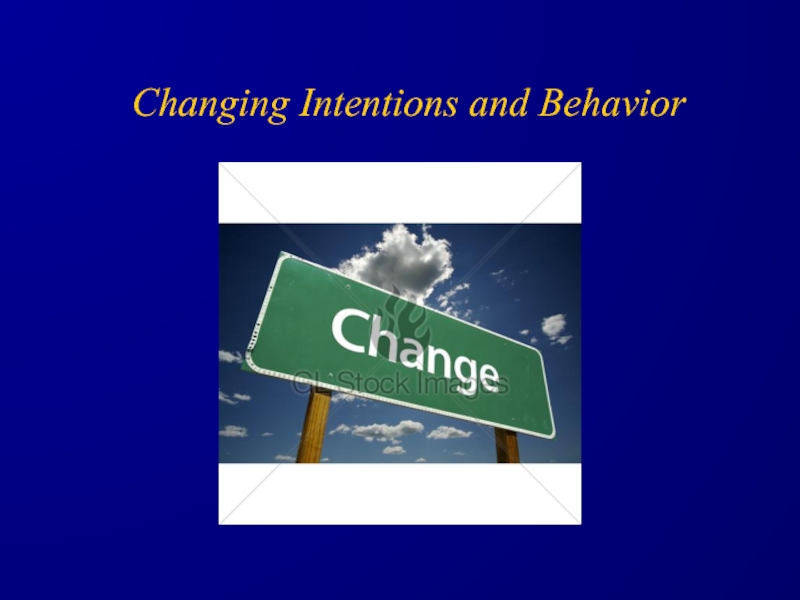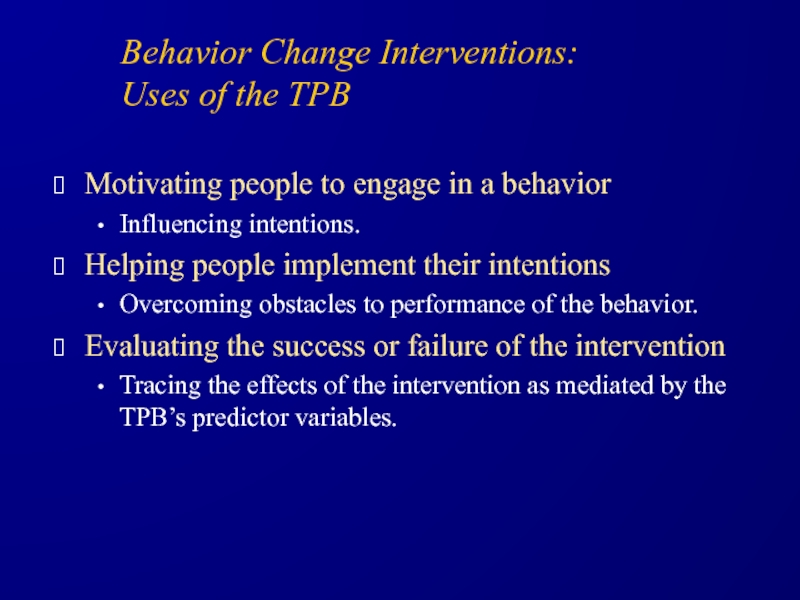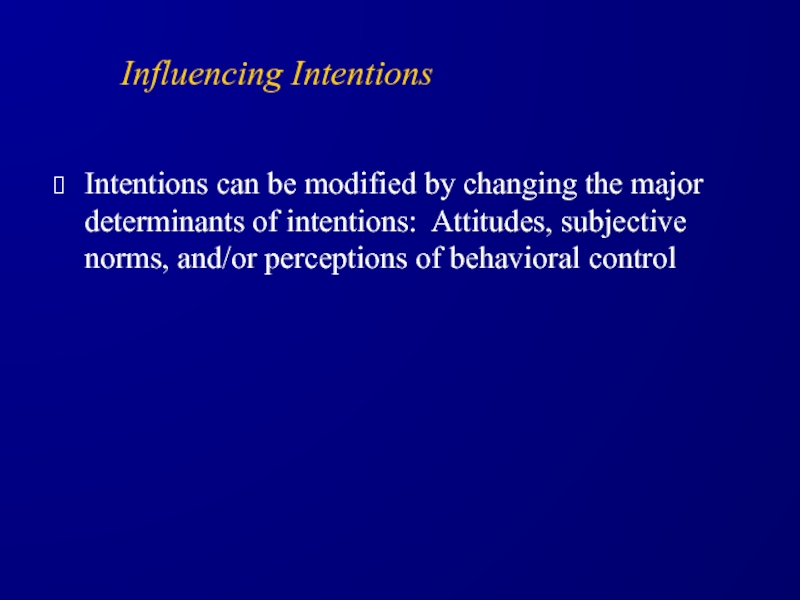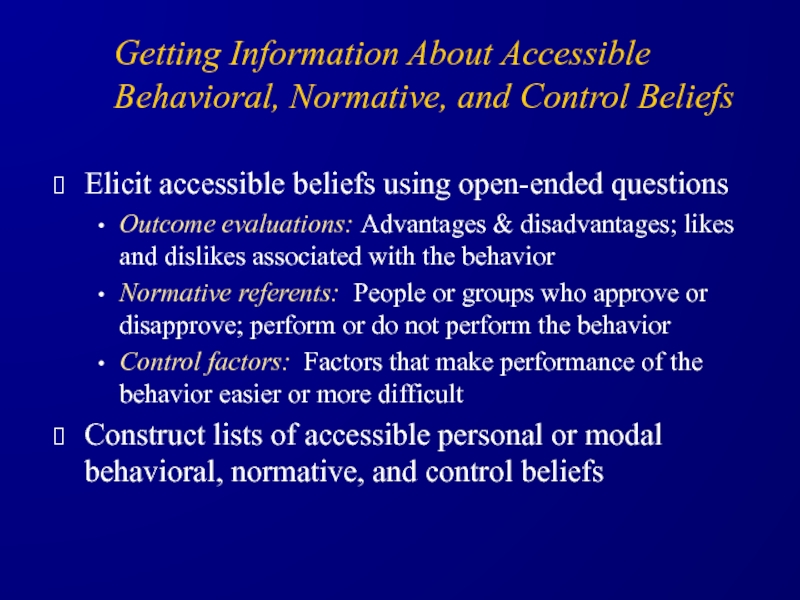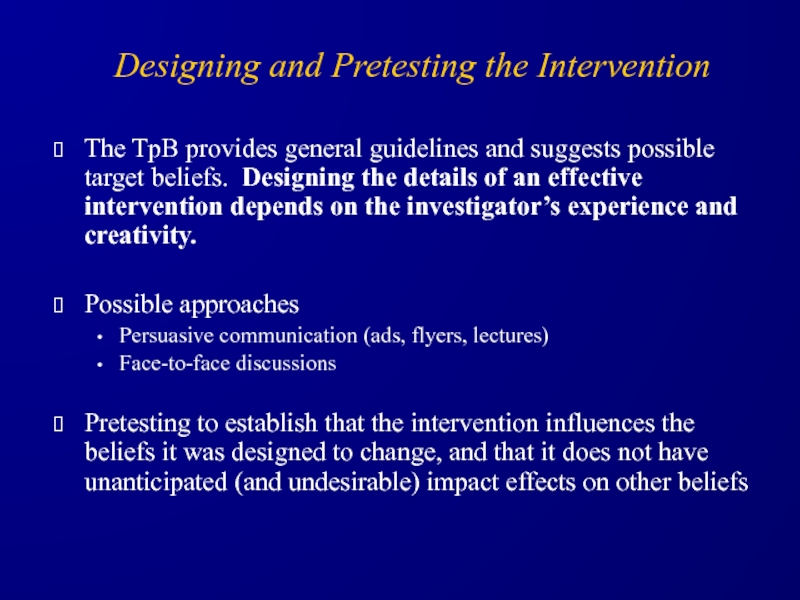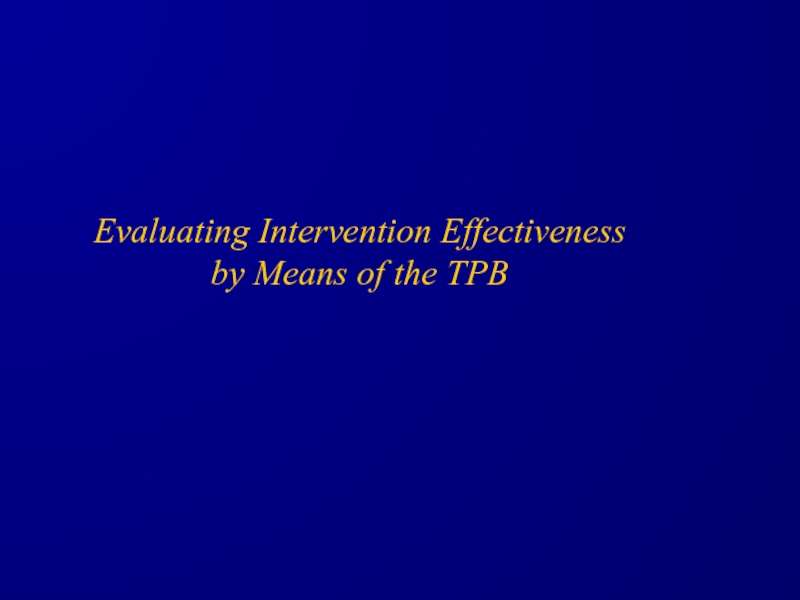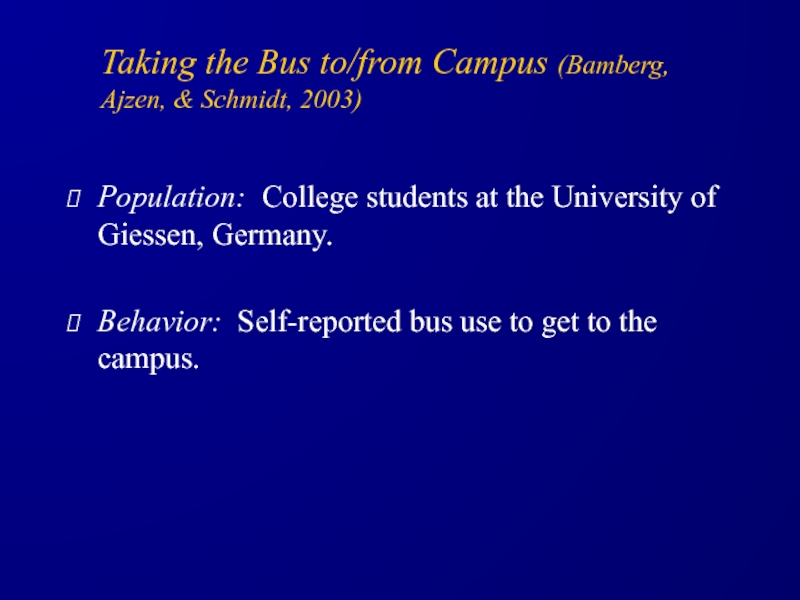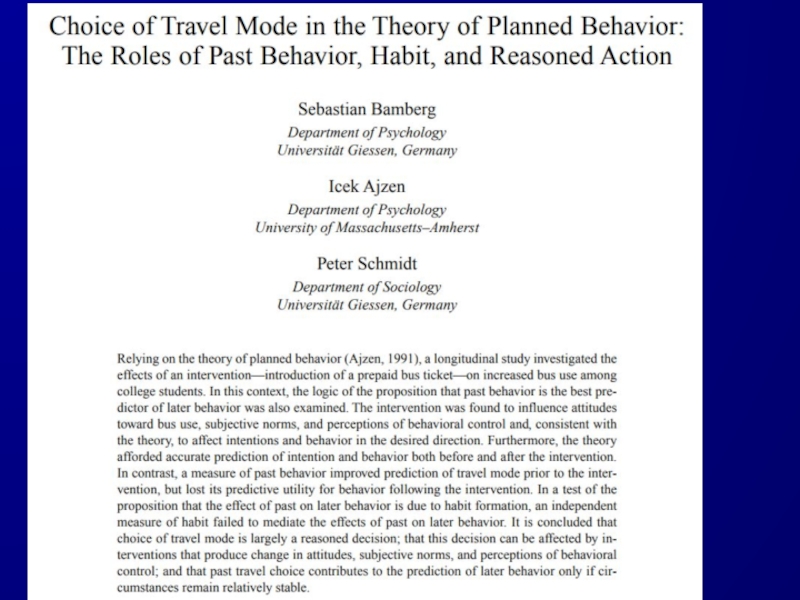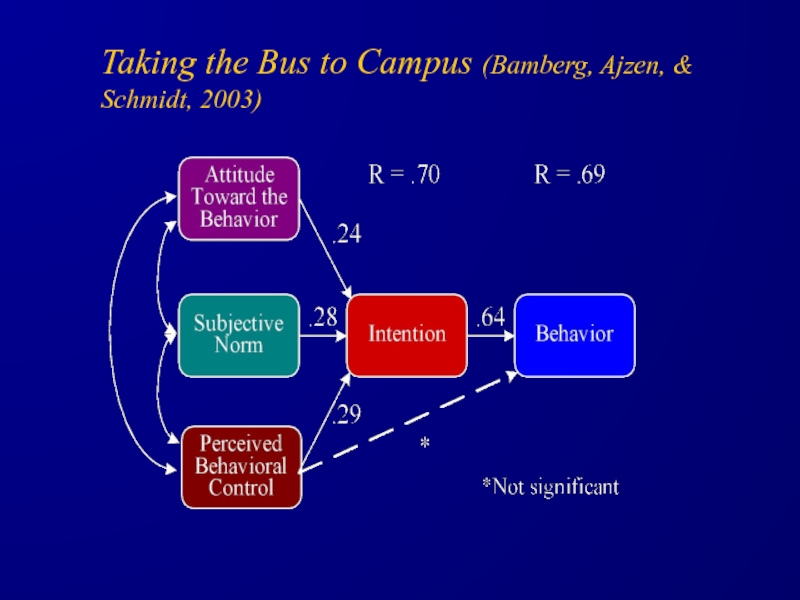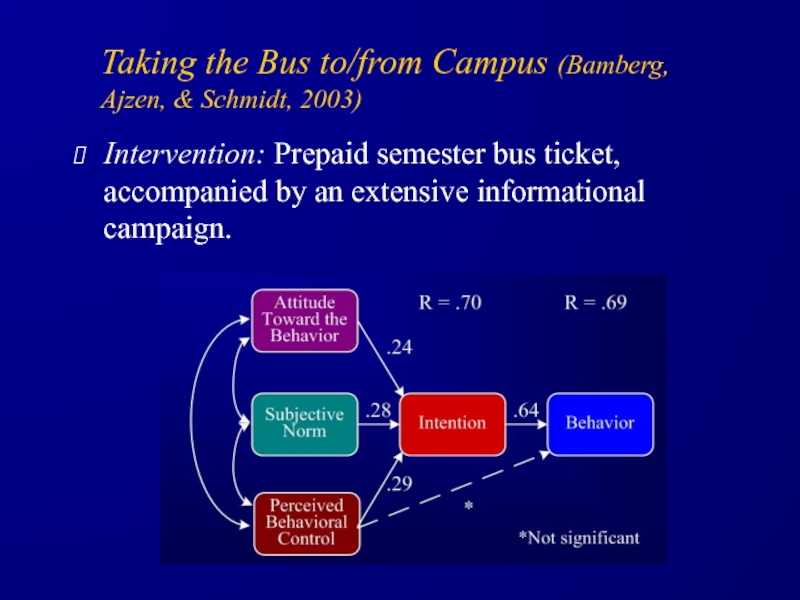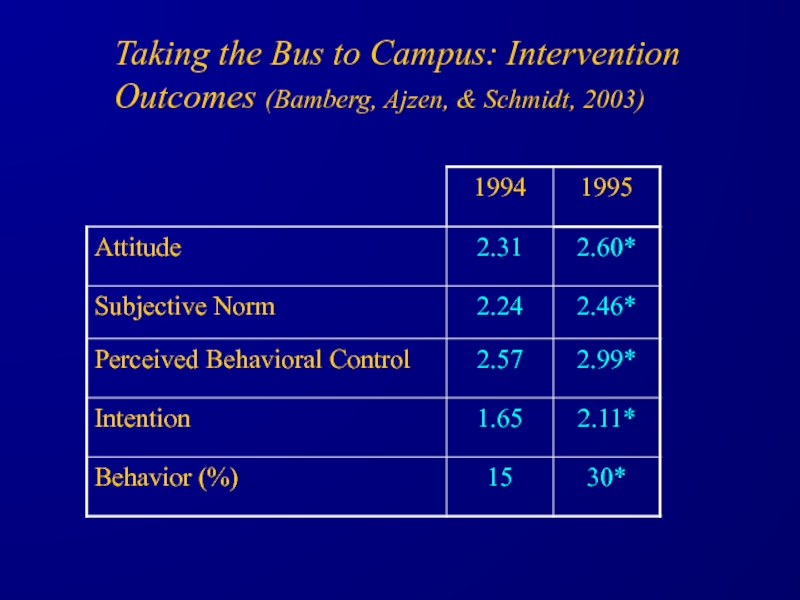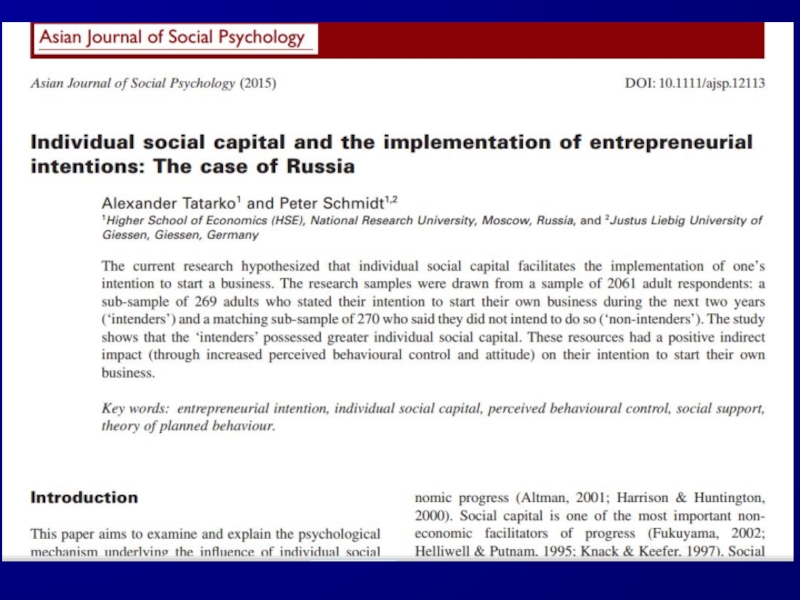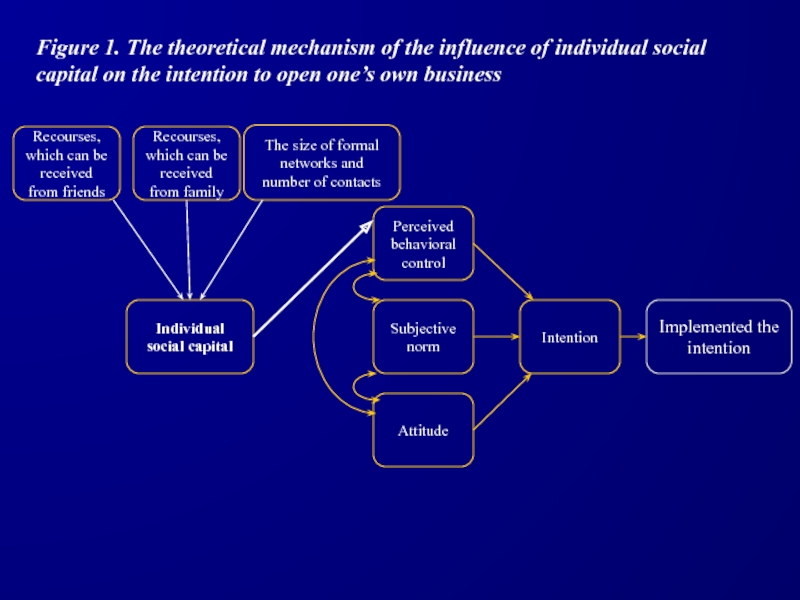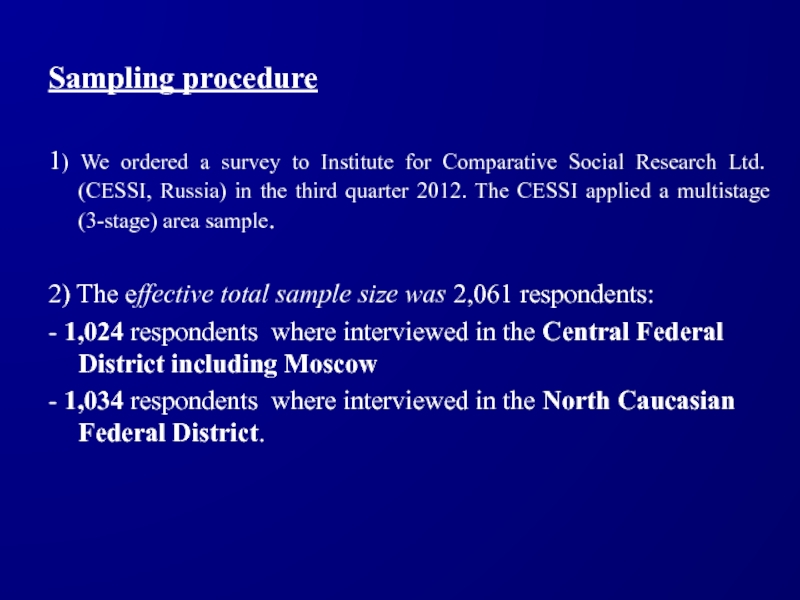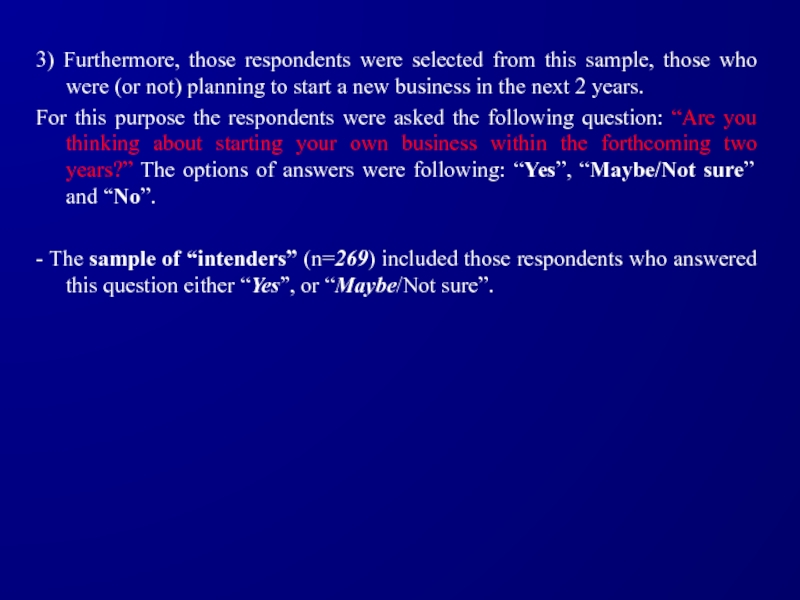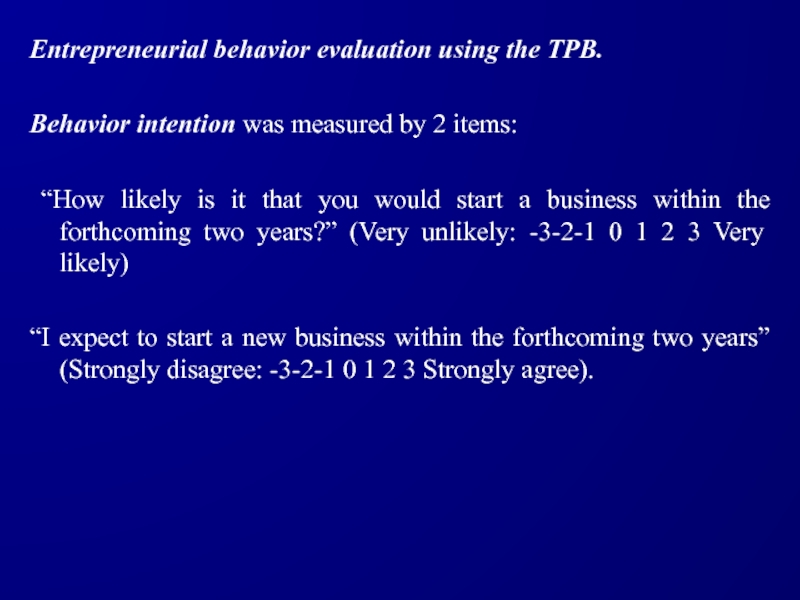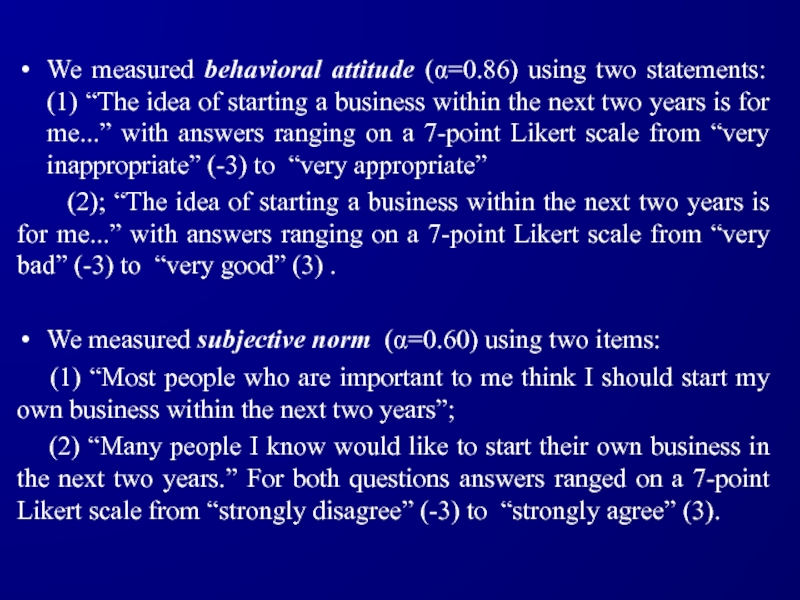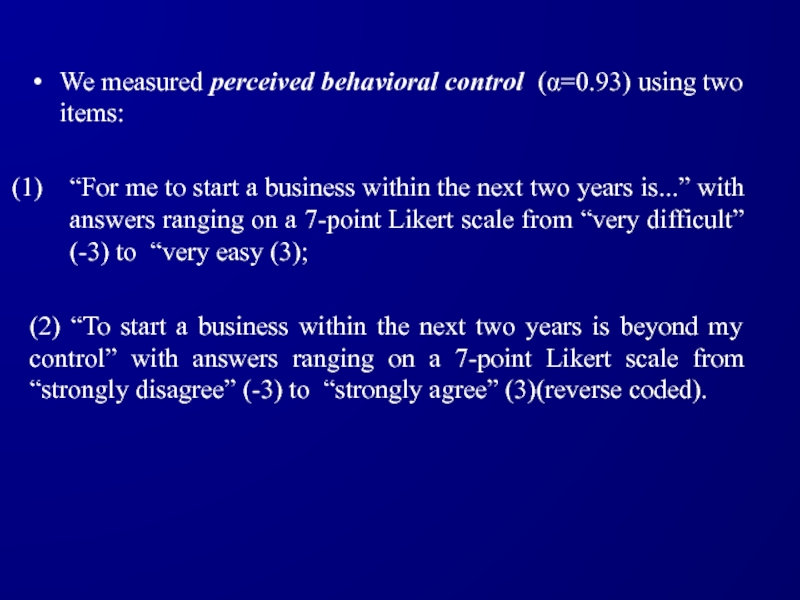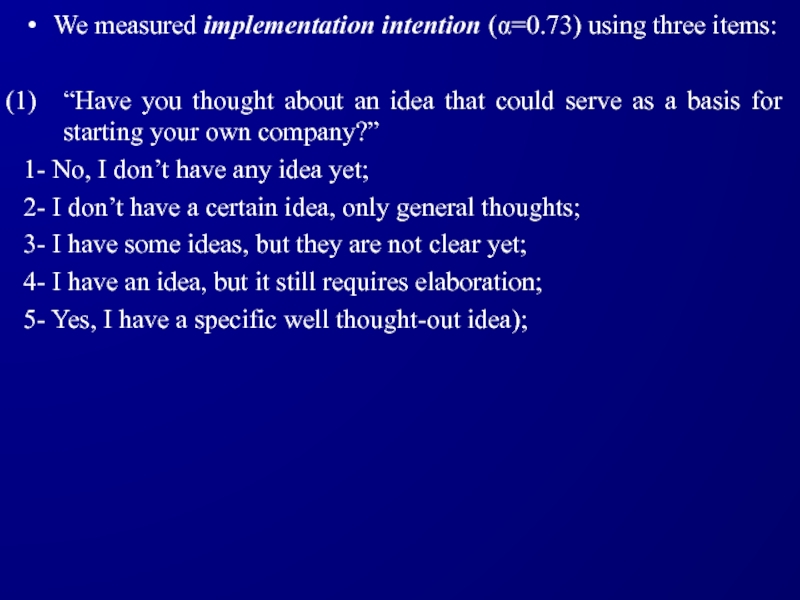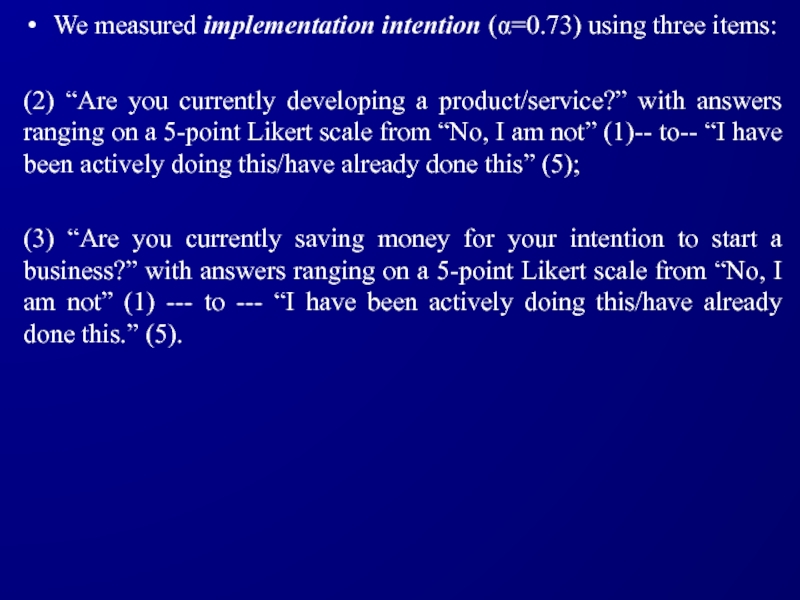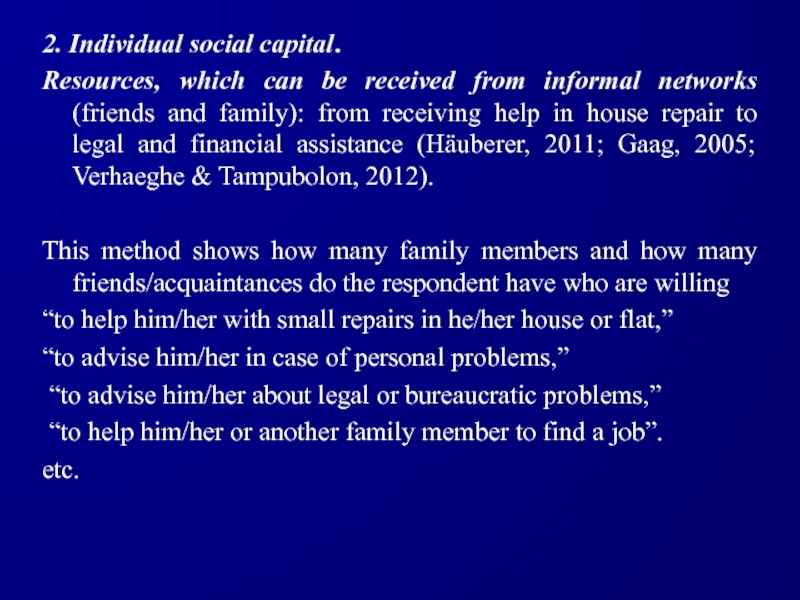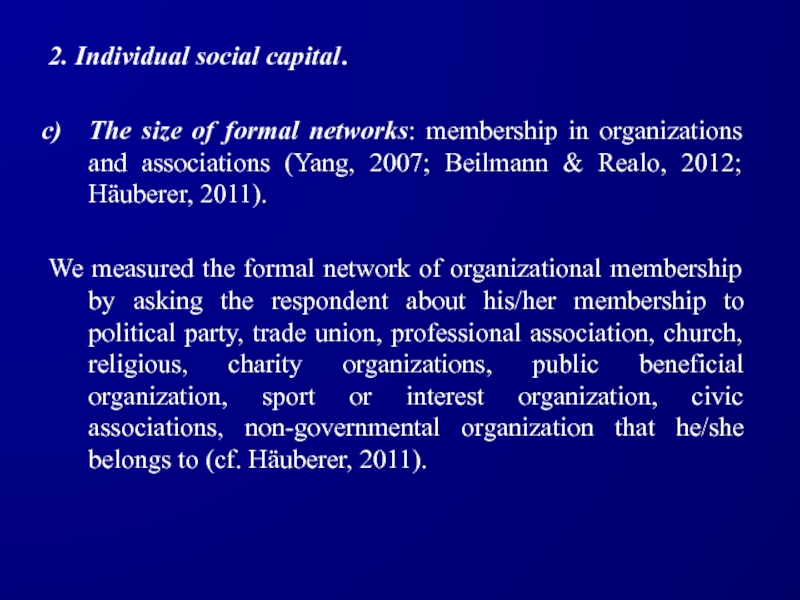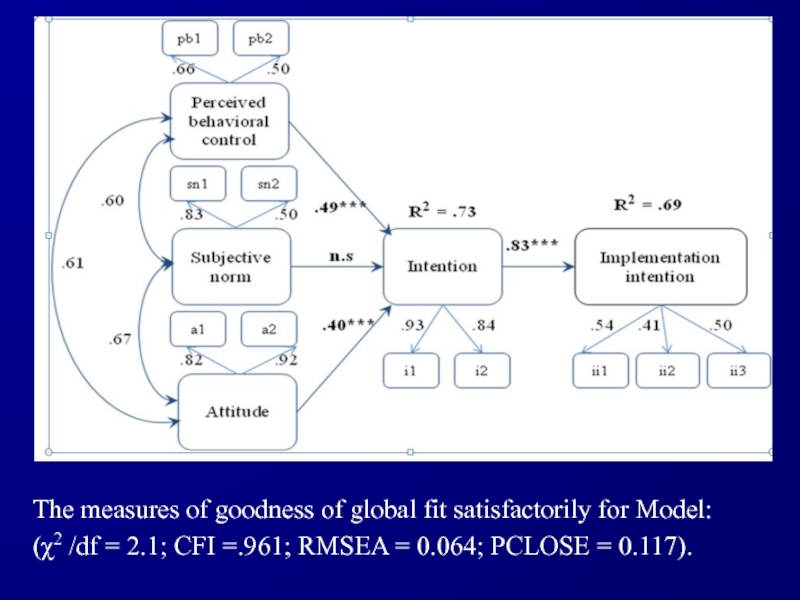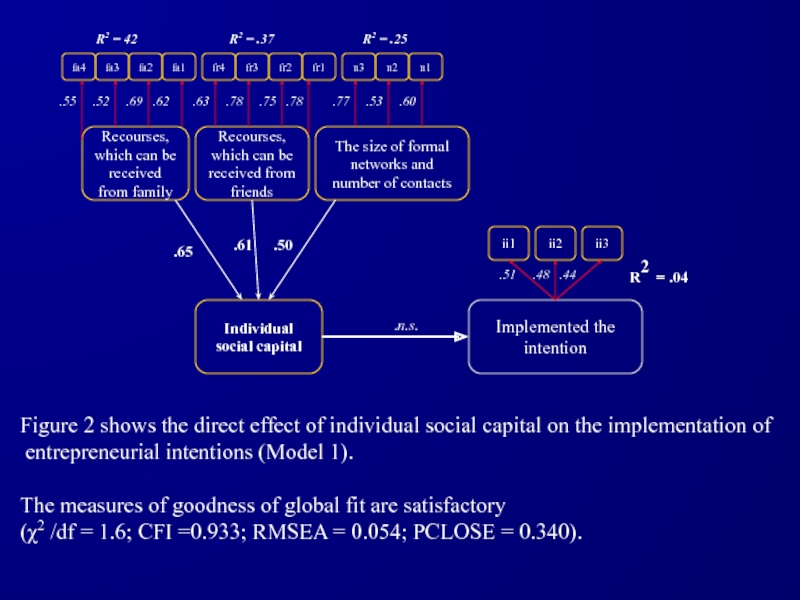- Главная
- Разное
- Дизайн
- Бизнес и предпринимательство
- Аналитика
- Образование
- Развлечения
- Красота и здоровье
- Финансы
- Государство
- Путешествия
- Спорт
- Недвижимость
- Армия
- Графика
- Культурология
- Еда и кулинария
- Лингвистика
- Английский язык
- Астрономия
- Алгебра
- Биология
- География
- Детские презентации
- Информатика
- История
- Литература
- Маркетинг
- Математика
- Медицина
- Менеджмент
- Музыка
- МХК
- Немецкий язык
- ОБЖ
- Обществознание
- Окружающий мир
- Педагогика
- Русский язык
- Технология
- Физика
- Философия
- Химия
- Шаблоны, картинки для презентаций
- Экология
- Экономика
- Юриспруденция
The Reasoned Action Approach презентация
Содержание
- 1. The Reasoned Action Approach
- 2. The Reasoned Action Approach
- 5. Fishbein and Ajzen’s Theory of Reasoned Action
- 6. Assumptions of the Model Human behavior is
- 7. Components of the Model Behavior is a
- 8. Theory of Reasoned Action (Ajzen & Fishbein
- 9. The Theory of Planned Behavior Ajzen (1991)
- 10. The Theory of Planned Behavior Ajzen (1991)
- 11. Background Factors
- 12. References to TPB in Google Scholar
- 13. Theory of Planned Behavior: Sample Applications
- 14. Direct Assessment of TPB Components
- 15. Nature of the Theory’s Components
- 16. Nature of the Theory’s Components
- 17. Intention Planning I intend to… I
- 18. Nature of the Theory’s Components
- 19. Instrumental vs. Experiential Attitudes Instrumental Good –
- 20. Nature of the Theory’s Components
- 21. Injunctive vs. Descriptive Norms Injunctive Most people
- 22. Nature of the Theory’s Components
- 23. Capacity vs. Autonomy Aspects of Perceived Control
- 24. Drinking Alcohol: TPB Attitude Measure (5-point scales)
- 25. Drinking Alcohol: TPB Subjective Norm Measure (5-point
- 26. Drinking Alcohol: TPB Perceived Behavioral Control Measure
- 27. Drinking Alcohol: TPB Intention Measure 1. I
- 28. Drinking Alcohol: Current Behavior Measure 1. Please
- 29. Sample Application: Physical Activity With Spinal Cord
- 30. Sample Application: Not Smoking (Godin, Valois, Lepage,
- 31. Sample Application: Driving After Drinking (Armitage, Norman,
- 32. TPB: Donating Blood (Giles & Cairns,
- 33. TPB: Energy Conservation (Ajzen, Joyce, Sheikh, &
- 34. Meta Analysis – Mean Correlations (K =185)
- 35. Changing Intentions and Behavior
- 36. Behavior Change Interventions: Uses of the TPB
- 37. Influencing Intentions Intentions can be modified by
- 38. Getting Information About Accessible Behavioral, Normative, and
- 39. Designing and Pretesting the Intervention The TpB
- 40. Evaluating Intervention Effectiveness by Means of the TPB
- 41. Taking the Bus to/from Campus (Bamberg, Ajzen,
- 43. Taking the Bus to Campus (Bamberg, Ajzen, & Schmidt, 2003)
- 44. Taking the Bus to/from Campus (Bamberg, Ajzen,
- 45. Taking the Bus to Campus: Intervention Outcomes (Bamberg, Ajzen, & Schmidt, 2003)
- 46. Individual Social Capital and the Implementation of Entrepreneurial Intentions: the case of Russia
- 48. Subjective norm Perceived behavioral control Attitude Intention
- 49. Sampling procedure 1) We ordered a
- 50. 3) Furthermore, those respondents were selected from
- 51. Entrepreneurial behavior evaluation using the TPB.
- 52. We measured behavioral attitude (α=0.86) using
- 53. We measured perceived behavioral control (α=0.93) using
- 54. We measured implementation intention (α=0.73) using
- 55. We measured implementation intention (α=0.73) using
- 56. 2. Individual social capital. Resources, which can
- 57. 2. Individual social capital. The size
- 58. The measures of goodness of global fit
- 59. Implemented the intention Recourses, which can be
- 60. The measures of goodness of
Слайд 5Fishbein and Ajzen’s Theory of Reasoned Action
Originally developed in 1967; further
By the 1980’s, very commonly used to study human behavior
Fishbein (U of I) and Ajzen (U Mass) were both working on similar concepts to explain human behavior, and eventually collaborated to create and publish the model in 1980.
Слайд 6Assumptions of the Model
Human behavior is under the voluntary control of
People think about the consequences and implications of their actions behavior the decide whether or not to do something.
Therefore, intention must be highly correlated with behavior.
Whether or not a person intends to perform a health behavior should correlate with whether or not they actually DO the behavior
Слайд 7Components of the Model
Behavior is a function of 2 things:
Attitudes toward
What will happen if I engage in this behavior?
Is this outcome desirable or undesirable
Subjective norms regarding that action
Normative beliefs: others expectations
Motivation to comply: do I want to do what they tell me? How much? Why?
Слайд 8Theory of Reasoned Action (Ajzen & Fishbein (1980) ) Behavioral beliefs means
Слайд 9The Theory of Planned Behavior
Ajzen (1991)
Behavioral
Beliefs
Attitude
toward the
Behavior
Normative
Beliefs
Subjective
Norm
Control
Beliefs
Perceived
Behavioral
Control
Intention
Behavior
Слайд 10The Theory of Planned Behavior
Ajzen (1991)
Behavioral
Beliefs
Attitude
toward the
Behavior
Normative
Beliefs
Subjective
Norm
Control
Beliefs
Perceived
Behavioral
Control
Intention
Behavior
Actual
Behavioral
Control
Слайд 17Intention
Planning
I intend to…
I am planning to…
Expectation
I expect to…
I will…
Willingness
I would…
I
Слайд 19Instrumental vs. Experiential Attitudes
Instrumental
Good – Bad
Useless – Useful
Harmful – Beneficial
Valuable –
Experiential (Affective)
Dull – Exciting
Painful – Enjoyable
Pleasant – Unpleasant
Boring – Interesting
Слайд 21Injunctive vs. Descriptive Norms
Injunctive
Most people who are important to me think
Most people whose opinions I value would approve…
Most people I respect think it is appropriate for me to …
It is expected of me that I …
Descriptive
Most people who are important to me engage in…
Most people like me perform…
Most people in my situation engage in …
Most people similar to me perform…
Слайд 23Capacity vs. Autonomy Aspects of Perceived Control
Capacity
I have the ability to…
I
I am confident that I can…
If I wanted to I could easily…
Autonomy
I have complete control over…
It is entirely up to me whether I…
There are few outside events that could prevent me from…
Doing X is beyond my control…
Слайд 24Drinking Alcohol: TPB Attitude Measure (5-point scales) - Ajzen, Joyce, Gilbert Cote,
For me to drink alcohol this semester would be…
1. Very unpleasant --- Very pleasant
2. Extremely undesirable --- Extremely desirable
3. Extremely bad --- Extremely good
4. Drinking alcohol this semester is something I would Strongly dislike --- Strongly like
α = .92
Слайд 25Drinking Alcohol: TPB Subjective Norm Measure (5-point scales)
1. People whose opinions
2. People who are close to me would approve of my drinking alcohol this semester.
3. Most people who are important to me will drink alcohol this semester.
4. People who are close to me expect me to drink alcohol this semester.
Strongly disagree --- Strongly agree
α = .85
Слайд 26Drinking Alcohol: TPB Perceived Behavioral Control Measure
1. If I wanted to,
Strongly disagree --- Strongly agree
2. For me to drink alcohol this semester is
Very impossible --- Very possible
3. It will be difficult for me to drink alcohol this semester.
Strongly disagree --- Strongly agree
4. I should have no trouble drinking alcohol this semester.
Strongly disagree --- Strongly agree
α = .71
Слайд 27Drinking Alcohol: TPB Intention Measure
1. I am planning to drink alcohol
Strongly disagree --- Strongly agree
2. I intend to drink alcohol this semester.
Definitely will not --- Definitely will
3. I will probably drink alcohol this semester.
Definitely will not --- Definitely will
4. I expect I will drink alcohol this semester.
Strongly disagree --- Strongly agree
α = .98
Слайд 28Drinking Alcohol: Current Behavior Measure
1. Please rate how often you drink
Never 1 2 3 4 5 6 7 Virtually every day
2. How many drinks do you typically consume on one occasion?
________ drinks
3. How would you describe yourself in terms of your current use of alcohol?
_____ abstainer _____ moderate drinker
_____ infrequent drinker _____ heavy drinker
_____ light drinker _____ chronic alcohol abuser
4. On how many occasions have you had one or more drinks in the past 30 days? _____ none _____ 6 to 9 occasions
_____ 1 to 2 occasions _____ 10 to 15 occasions
_____ 3 to 5 occasions _____ more than 16 occasions
α = .79
Слайд 29Sample Application: Physical Activity With Spinal Cord Injury – Latimer &
Subjective Norm
Attitude toward the Behavior
Perceived Behavioral
Control
Intention
Behavior
.29
.27
.47
R2 = . 17
–.05*
*not significant
.45
R2 = .61
Слайд 30Sample Application: Not Smoking
(Godin, Valois, Lepage, & Desharnais, 1992)
Subjective Norm
Attitude toward
Perceived Behavioral
Control
Intention
Behavior
.22
.17
.55
R2 = . 27
.42
.16
R2 = .39
Слайд 31Sample Application: Driving After Drinking
(Armitage, Norman, & Conner, 2002)
Subjective Norm
Attitude toward
Perceived Behavioral
Control
Intention
Behavior
.34
.41
.23
R2 = .67
Слайд 36Behavior Change Interventions:
Uses of the TPB
Motivating people to engage in a
Influencing intentions.
Helping people implement their intentions
Overcoming obstacles to performance of the behavior.
Evaluating the success or failure of the intervention
Tracing the effects of the intervention as mediated by the TPB’s predictor variables.
Слайд 37Influencing Intentions
Intentions can be modified by changing the major determinants of
Слайд 38Getting Information About Accessible Behavioral, Normative, and Control Beliefs
Elicit accessible beliefs
Outcome evaluations: Advantages & disadvantages; likes and dislikes associated with the behavior
Normative referents: People or groups who approve or disapprove; perform or do not perform the behavior
Control factors: Factors that make performance of the behavior easier or more difficult
Construct lists of accessible personal or modal behavioral, normative, and control beliefs
Слайд 39Designing and Pretesting the Intervention
The TpB provides general guidelines and suggests
Possible approaches
Persuasive communication (ads, flyers, lectures)
Face-to-face discussions
Pretesting to establish that the intervention influences the beliefs it was designed to change, and that it does not have unanticipated (and undesirable) impact effects on other beliefs
Слайд 41Taking the Bus to/from Campus (Bamberg, Ajzen, & Schmidt, 2003)
Population: College
Behavior: Self-reported bus use to get to the campus.
Слайд 44Taking the Bus to/from Campus (Bamberg, Ajzen, & Schmidt, 2003)
Intervention: Prepaid
Слайд 46Individual Social Capital and the Implementation of Entrepreneurial Intentions: the case
Слайд 48Subjective norm
Perceived behavioral control
Attitude
Intention
Implemented the intention
Recourses, which can be received
Recourses, which can be received from family
The size of formal networks and number of contacts
Individual social capital
Figure 1. The theoretical mechanism of the influence of individual social capital on the intention to open one’s own business
Слайд 49Sampling procedure
1) We ordered a survey to Institute for Comparative Social
2) The effective total sample size was 2,061 respondents:
- 1,024 respondents where interviewed in the Central Federal District including Moscow
- 1,034 respondents where interviewed in the North Caucasian Federal District.
Слайд 503) Furthermore, those respondents were selected from this sample, those who
For this purpose the respondents were asked the following question: “Are you thinking about starting your own business within the forthcoming two years?” The options of answers were following: “Yes”, “Maybe/Not sure” and “No”.
- The sample of “intenders” (n=269) included those respondents who answered this question either “Yes”, or “Maybe/Not sure”.
Слайд 51Entrepreneurial behavior evaluation using the TPB.
Behavior intention was measured by 2
“How likely is it that you would start a business within the forthcoming two years?” (Very unlikely: -3-2-1 0 1 2 3 Very likely)
“I expect to start a new business within the forthcoming two years” (Strongly disagree: -3-2-1 0 1 2 3 Strongly agree).
Слайд 52
We measured behavioral attitude (α=0.86) using two statements: (1) “The idea
(2); “The idea of starting a business within the next two years is for me...” with answers ranging on a 7-point Likert scale from “very bad” (-3) to “very good” (3) .
We measured subjective norm (α=0.60) using two items:
(1) “Most people who are important to me think I should start my own business within the next two years”;
(2) “Many people I know would like to start their own business in the next two years.” For both questions answers ranged on a 7-point Likert scale from “strongly disagree” (-3) to “strongly agree” (3).
Слайд 53We measured perceived behavioral control (α=0.93) using two items:
“For me to
(2) “To start a business within the next two years is beyond my control” with answers ranging on a 7-point Likert scale from “strongly disagree” (-3) to “strongly agree” (3)(reverse coded).
Слайд 54
We measured implementation intention (α=0.73) using three items:
“Have you thought
1- No, I don’t have any idea yet;
2- I don’t have a certain idea, only general thoughts;
3- I have some ideas, but they are not clear yet;
4- I have an idea, but it still requires elaboration;
5- Yes, I have a specific well thought-out idea);
Слайд 55
We measured implementation intention (α=0.73) using three items:
(2) “Are you
(3) “Are you currently saving money for your intention to start a business?” with answers ranging on a 5-point Likert scale from “No, I am not” (1) --- to --- “I have been actively doing this/have already done this.” (5).
Слайд 562. Individual social capital.
Resources, which can be received from informal networks
This method shows how many family members and how many friends/acquaintances do the respondent have who are willing
“to help him/her with small repairs in he/her house or flat,”
“to advise him/her in case of personal problems,”
“to advise him/her about legal or bureaucratic problems,”
“to help him/her or another family member to find a job”.
etc.
Слайд 572. Individual social capital.
The size of formal networks: membership in organizations
We measured the formal network of organizational membership by asking the respondent about his/her membership to political party, trade union, professional association, church, religious, charity organizations, public beneficial organization, sport or interest organization, civic associations, non-governmental organization that he/she belongs to (cf. Häuberer, 2011).
Слайд 58The measures of goodness of global fit satisfactorily for Model:
(χ2
Слайд 59Implemented the intention
Recourses, which can be received from family
Recourses, which can
The size of formal networks and number of contacts
Individual social capital
.65
.61
.50
.n.s.
fa3
fa4
fa2
fa1
fr4
fr3
fr2
fr1
.55
.52
.69
.62
.63
.78
.75
.78
n3
n2
n1
.77
.53
.60
ii1
ii2
ii3
.51
.48
.44
R2 = .04
R2 = .25
R2 = 42
R2 = .37
Figure 2 shows the direct effect of individual social capital on the implementation of
entrepreneurial intentions (Model 1).
The measures of goodness of global fit are satisfactory
(χ2 /df = 1.6; CFI =0.933; RMSEA = 0.054; PCLOSE = 0.340).
